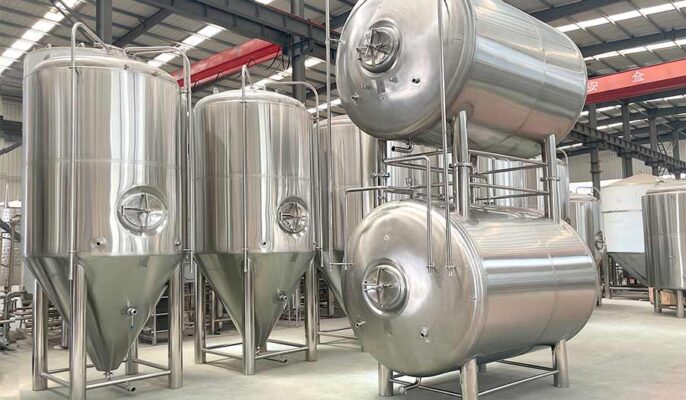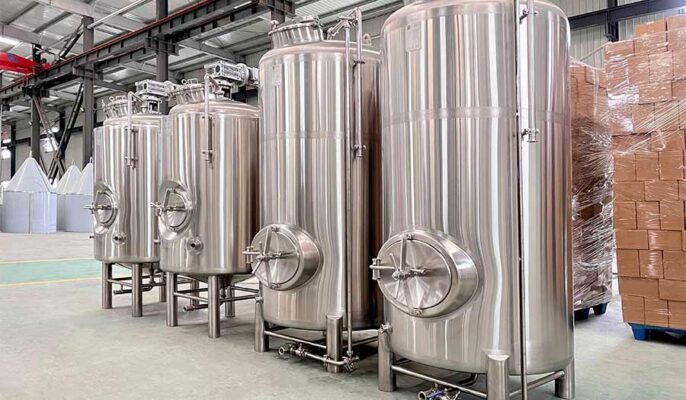Stainless steel brewing tanks are an essential part of the beer production process. Made from high-grade stainless steel, these tanks provide an ideal environment for fermenting and conditioning beer. Whether it’s a large commercial operation or a small microbrewery, it’s an important part of a brewery.
What is a stainless steel brewing tank?
Stainless steel brewing tanks are an essential part of the beer production process. Made from high-grade stainless steel, these tanks provide an ideal environment for fermenting and conditioning beer.
Features of stainless steel:
- Material: Stainless steel is known for its non-corrosive properties and is ideal for long-term storage of liquids.
- Design: These tanks come in a variety of designs, but most are cylindrical with a conical bottom to collect yeast and other sediments.
- Durability: Due to the stainless steel construction, these tanks are durable, rust and rust resistant.
- Temperature control: Many tanks have integrated cooling jackets or coils to maintain the precise temperature required for fermentation.
- Hygiene: The non-porous surface of stainless steel prevents bacterial growth, ensuring your beer remains free of contamination.
Types of stainless steel tanks
| TANK TYPE | DESCRIPTION |
| Unitank/Uni-tank | A single vessel used for both fermentation and conditioning/aging. Eliminates the need for separate tanks. |
| Conical Fermenters | Cylindrical tanks with a conical bottom, designed for efficient yeast collection and removal. |
| Cylindrical Fermenters | Straight-sided cylindrical tanks, often used for primary fermentation. |
| Bright Beer Tanks | Used for conditioning and carbonating the beer after fermentation. |
| Brite Tanks | Insulated tanks for storing and serving the finished beer. |

Features of stainless steel brewing tanks
- Temperature regulation: Fermentation is a temperature-sensitive process. Stainless steel tanks often come with built-in cooling jackets or coils to ensure the beer is fermented at the optimal temperature.
- Prevent aeration: Exposure to oxygen will reduce beer quality. These tanks are designed to be airtight to prevent unnecessary oxygen exposure.
- Yeast collection: The tapered bottom of many brewing tanks helps collect and remove yeast after fermentation, promoting beer clarification.
- Carbonation: Beer can be carbonated by introducing carbon dioxide in tanks designed for this purpose, allowing precise carbonation levels to be achieved.
- Beer storage: After brewing, beer needs to be stored in a controlled environment before being packaged or consumed. These tanks ensure the beer stays in top condition.
- Safety: These tanks are equipped with pressure relief valves that release excess pressure to ensure safety during the fermentation process, which produces large amounts of carbon dioxide.
The choice of brewing tank type depends on the specific requirements of the brewing process. While some breweries may need specialized tanks for each stage, others may opt for combination tanks that serve many purposes.
Advantages and Disadvantages of Stainless Steel Brewing Tanks
Like any brewing equipment, stainless steel tanks come with their own set of advantages and limitations.
Let’s take a look at some of the key pros and cons:
| PROS | CONS |
| Durability and longevity | Higher initial investment cost |
| Corrosion resistance | Potential for scratches or dents |
| Easy to clean and sanitize | Skilled labor required for installation and maintenance |
| Versatility in tank sizes and designs | Potential for off-flavors if not properly passivated |
| Maintains consistent temperatures | Bulky and heavy, requiring proper floor support |

How to choose the stainless steel brewing tank that’s right for you?
Choosing the right stainless steel brew tank is a decision that can impact your brewery’s operations for years to come.
- Determine purpose: Are you looking for a fermenter, service tank or mash tun? Different stages of brewing need specific types of tanks.
- Capacity requirements: Size matters. If you are a small-batch craft brewery, a 500-liter beer tank may be enough. But, larger breweries may must tanks with capacities up to 30,000 liters or more.
- Space Limitations: Before investing, measure the available space you have. This includes not only floor space but also height. Some tanks are very tall and you need to make sure they fit in your facility.
- Budget: While it’s tempting to go with the cheapest option, remember that this is a long-term investment. Balancing cost and quality is critical. Consider factors such as warranty, brand reputation and potential operational savings.
- Features: Modern brewing tanks have many functions. Some have integrated temperature control systems, while others may offer advanced yeast collection mechanisms or adjustable carbonation systems.
- Material grade: Not all stainless steel is created equal. For brewing tanks, it is often recommended to choose 304 or 316 stainless steel due to their corrosion resistance and durability.
There are countless options on the market, and by understanding your specific needs and weighing each factor, you can of course seek help from a Micet engineer. We provide stainless steel brewing tanks of various sizes and types, and also support customized services, which can help you solve the difficulties you encounter.
Advantages of stainless steel brewing tanks in China
| MANUFACTURER | SPECIALTIES |
| Blichmann Engineering | High-quality, innovative designs |
| SS Brewtech | Professional-grade tanks for all scales |
| Bru Gear | Durable and efficient vessels |
| JV Northwest | Custom-made brewing solutions |
| Portland Kettle Works | Craftsmanship combined with technology |
| GW Kent | Comprehensive brewing equipment range |
| Glacier Tanks | Versatility in brewing and distilling |
| DME Process Systems | Global expertise and custom designs |
| Stout Tanks and Kettles | Aesthetics and efficiency |
| Ziemann Holvrieka | Pioneering technology with a rich history |
Applications of stainless steel brewing tanks
- Craft breweries: With the rise of craft beer, small and medium-sized breweries often use these tanks due to their efficiency and scalability.
- Large breweries: These operations need large amounts of storage and fermentation capacity. Stainless steel tanks offer durability and consistency, which are critical for large-scale beer production.
- Home Brewing: The popularity of home brewing has led to the creation of small stainless steel tanks designed for personal use. These provide homebrewers with a professional-grade brewing experience.
- Beer bars and beer rooms: Beer cans are popular here, and beer can be served from the can to the tap to ensure freshness.
- Professional Brewing: Besides to beer, these tanks can be used to brew kombucha, cider, or other fermented beverages, demonstrating their versatility.
FAQ
Q: How often do stainless steel brewing tanks need to be cleaned?
A: The water tank should be cleaned after each use to prevent contamination and maintain proper hygiene. Frequency may vary based on the brewery’s production schedule and cleaning regimen.
Q: How long do stainless steel brew tanks last?
A: With proper care and maintenance, high-quality stainless steel tanks can last for decades and are a worthwhile investment for a brewery.
Q: How does MICET ensure the quality of brewing tanks?
A: MICET has a state-of-the-art factory and maintains strict quality control measures. Each tank undergoes rigorous testing and inspection to ensure it meets company and international standards.
Q: Can MICET customize brew tanks to unique brewery specifications?
A: Yes, MICET is known for its customization capabilities. They work with their customers to ensure that each brew tank is tailored to the brewery’s specific needs, whether that’s size, design or special features.




